Part 2 - Vlinderhof - with carexTours
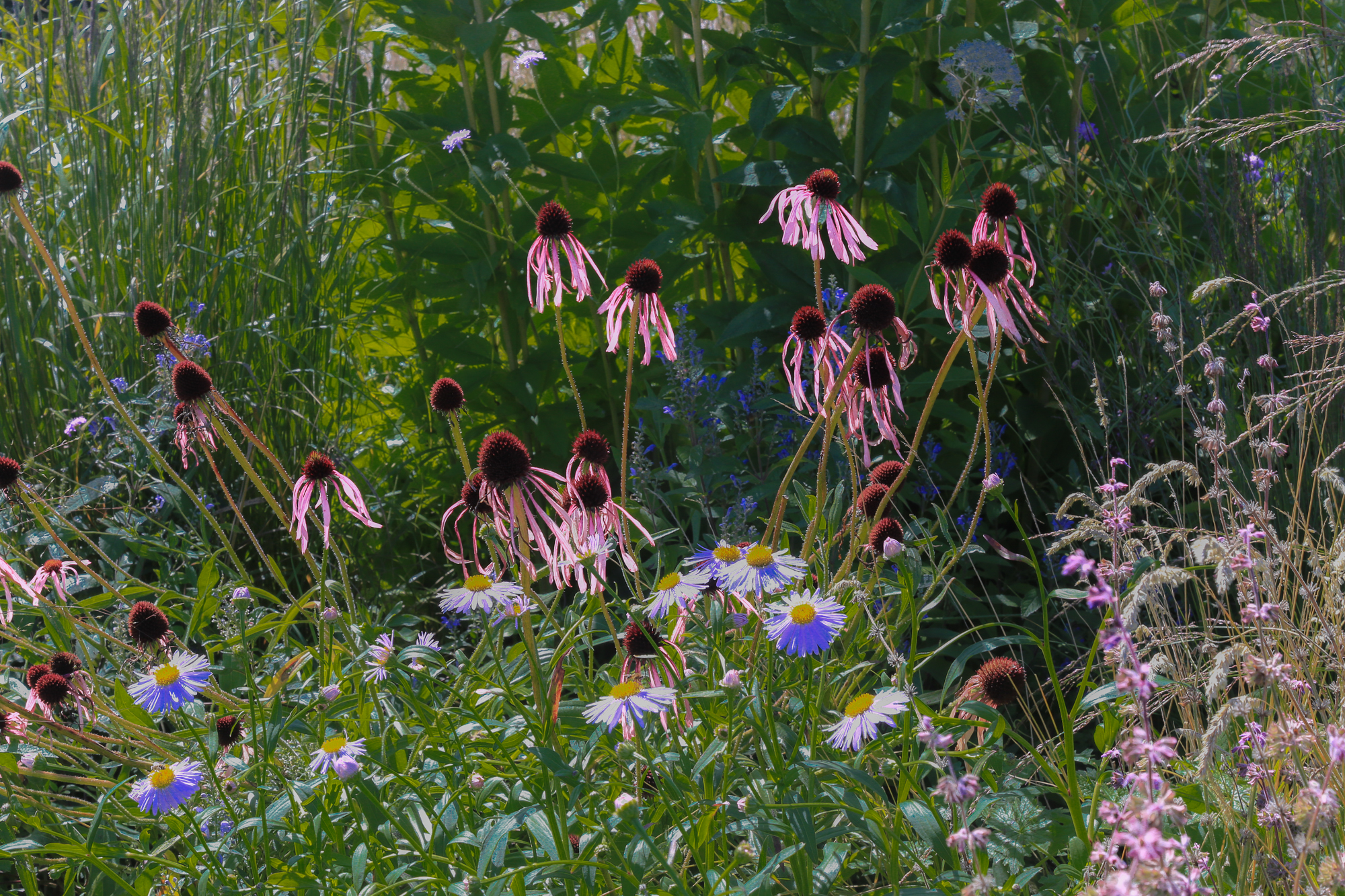 As a member of Carolyn Mullet's Dutch Wave tour in August 2016, I joined an extraordinary group of international garden travelers with a special interest in the work of Piet Oudolf and many practitioners of the garden design movement he largely founded ... the Dutch Wave, often called the New Perennial movement. The carexTours itinerary gave us a superb overview of Piet Oudolf's work and Dutch Wave design, as well as glimpses into work of several other major garden designers, all packed into a week of two garden visits (sometimes three) each day. We also visited a couple of magnificent nurseries, a museum, a garden tool maker, and a palace. Over the next few months, I’ll be telling you about my own experience on this great tour.If you know of someone who might like a garden tour as a very special Holiday gift, I can't think of a better place to go than carexTours. Just click on carexTours anywhere in this post for more information.
As a member of Carolyn Mullet's Dutch Wave tour in August 2016, I joined an extraordinary group of international garden travelers with a special interest in the work of Piet Oudolf and many practitioners of the garden design movement he largely founded ... the Dutch Wave, often called the New Perennial movement. The carexTours itinerary gave us a superb overview of Piet Oudolf's work and Dutch Wave design, as well as glimpses into work of several other major garden designers, all packed into a week of two garden visits (sometimes three) each day. We also visited a couple of magnificent nurseries, a museum, a garden tool maker, and a palace. Over the next few months, I’ll be telling you about my own experience on this great tour.If you know of someone who might like a garden tour as a very special Holiday gift, I can't think of a better place to go than carexTours. Just click on carexTours anywhere in this post for more information. Having seen hundreds of photographs of Vlinderhof, I arrived expecting something extraordinary. I certainly found that. What I hadn't expected, probably because I was so dazzled by the photos of the plants that I wasn't paying attention, was finding a well used public park, so very different from Piet Oudolf's own personal garden at Hummelo, which we visited in my last post on Carolyn's Dutch Wave tour.
Having seen hundreds of photographs of Vlinderhof, I arrived expecting something extraordinary. I certainly found that. What I hadn't expected, probably because I was so dazzled by the photos of the plants that I wasn't paying attention, was finding a well used public park, so very different from Piet Oudolf's own personal garden at Hummelo, which we visited in my last post on Carolyn's Dutch Wave tour.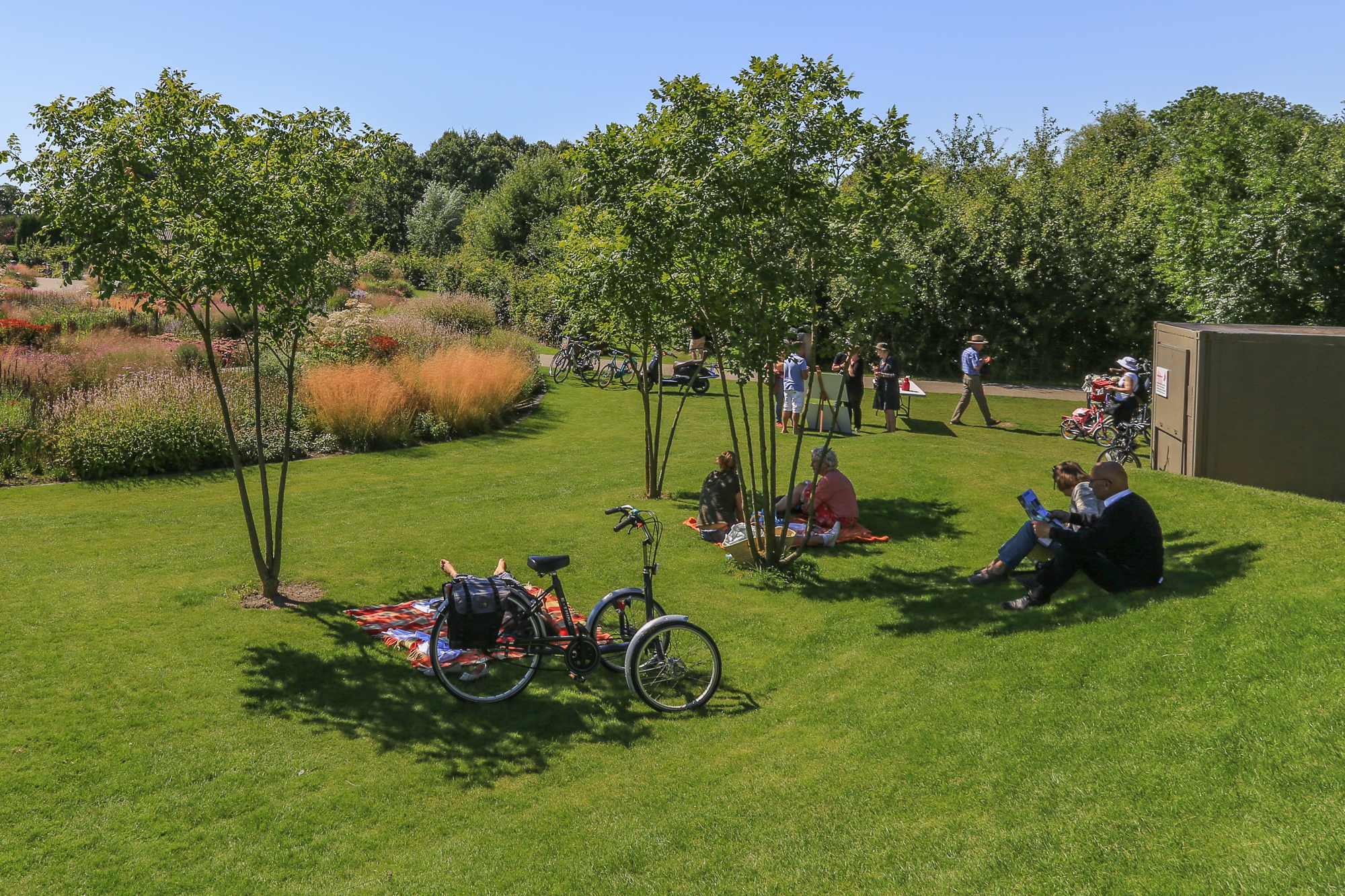 My first view of Vlinderhof was from the high ground at its edge. Vlinderhof is just a part, though a very dear part, of the much larger Maximapark near Utrecht. It occupies a shallow bowl of space shaped by berms built up on this front side and screened from the larger Maximapark by a loose circle of hedges and trees.
My first view of Vlinderhof was from the high ground at its edge. Vlinderhof is just a part, though a very dear part, of the much larger Maximapark near Utrecht. It occupies a shallow bowl of space shaped by berms built up on this front side and screened from the larger Maximapark by a loose circle of hedges and trees. Space is precious in The Netherlands where individual houses have much less land for personal use than in the US. So public parks are well used amenities and, in general, the Dutch pay far more attention to the quality and maintenance of their parks than do Americans.
Space is precious in The Netherlands where individual houses have much less land for personal use than in the US. So public parks are well used amenities and, in general, the Dutch pay far more attention to the quality and maintenance of their parks than do Americans.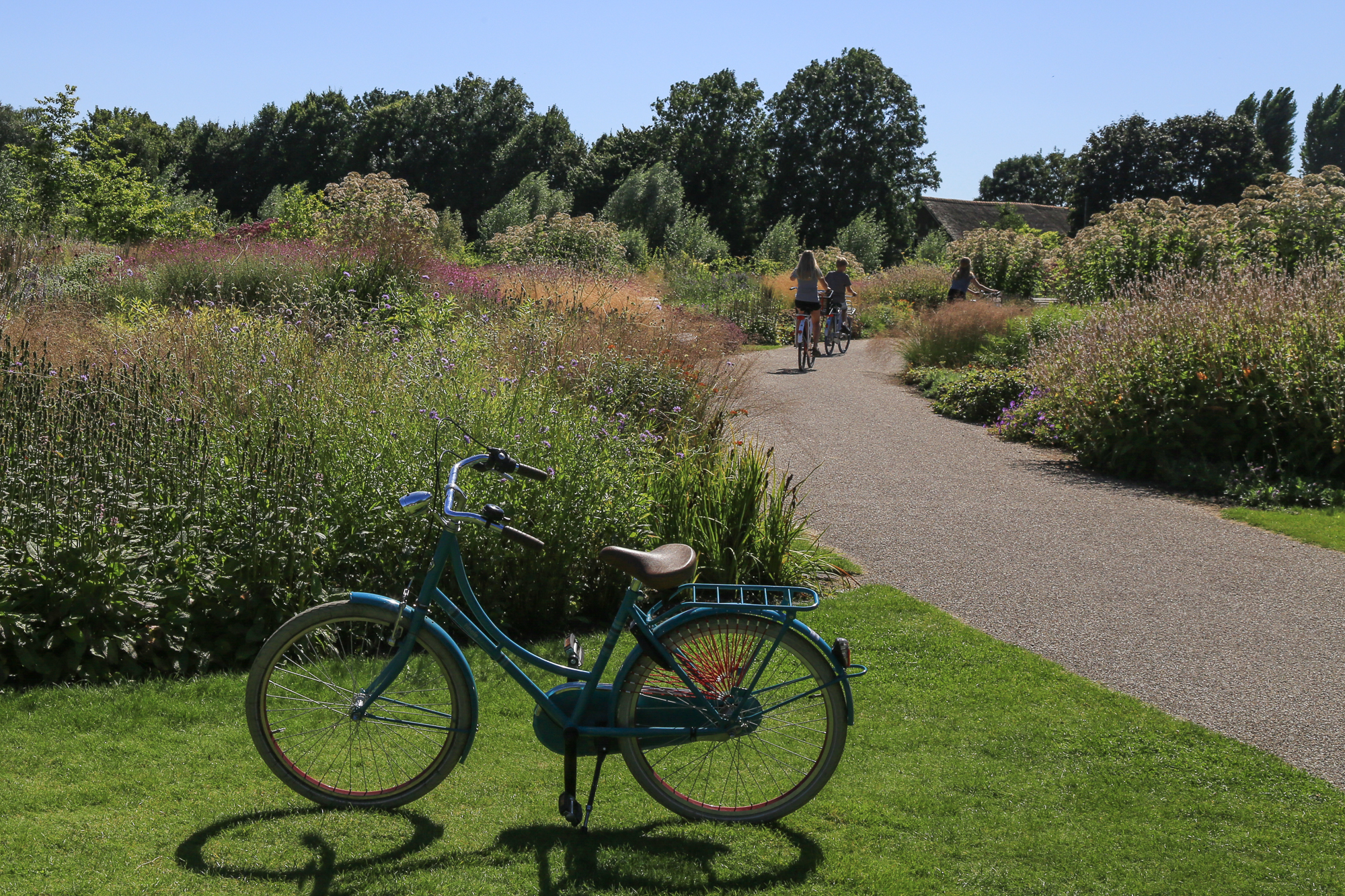 I think you can see this landscape literally radiates a sense of care and appreciative use.
I think you can see this landscape literally radiates a sense of care and appreciative use.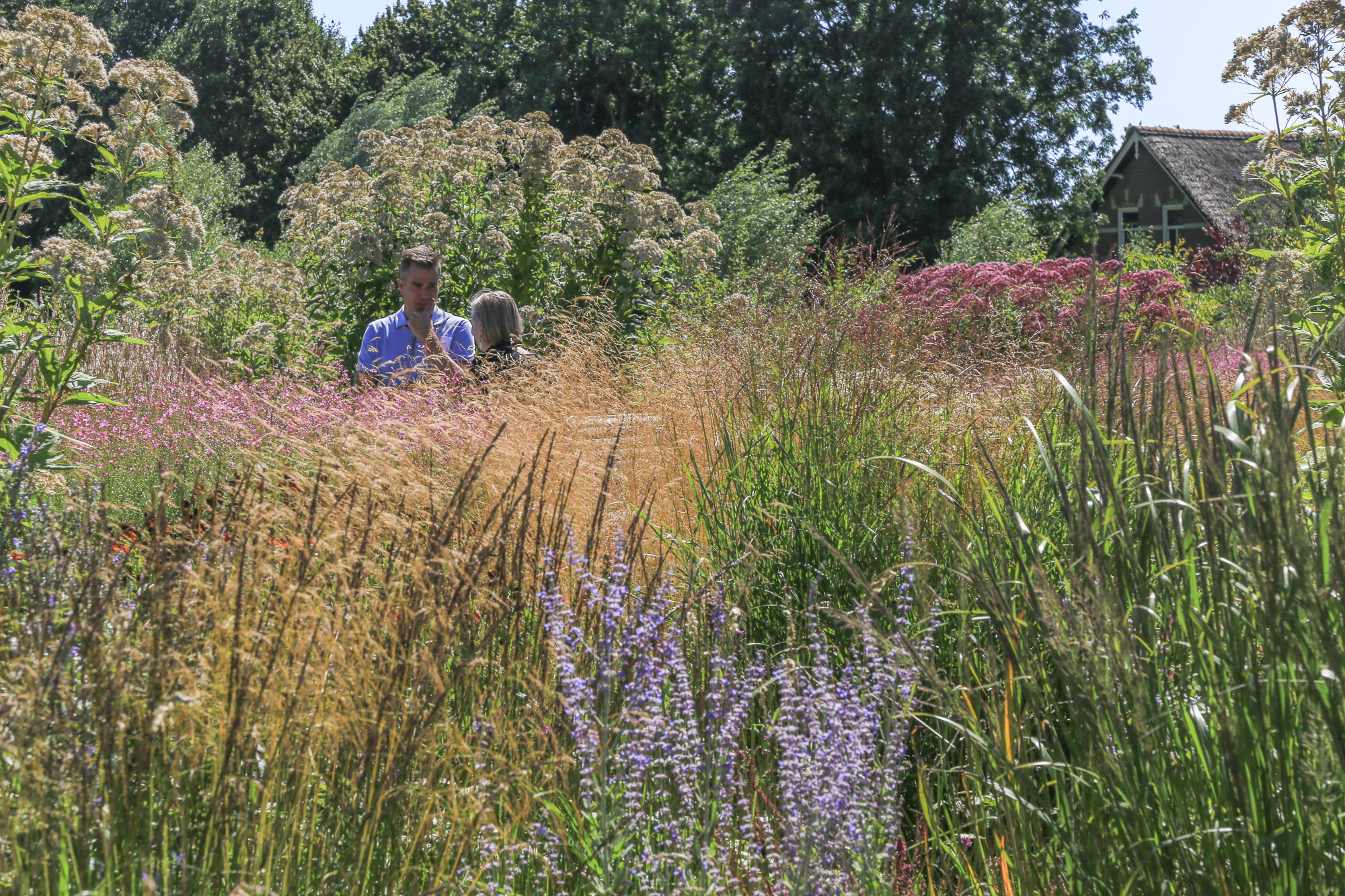 Vlinderhof (which means "butterfly garden" in Dutch) only came into being recently. The idea for an Oudolf garden in this place came from local resident and gardener Marc Kikkert, shown above talking with our tour leader Carolyn Mullet. Long an admirer of Piet Oudolf, Marc conceived the idea of turning an unused part of Maximapark into a garden that would be designed by Oudolf. He led the effort and worked tirelessly to develop interest, public support, funding, and then to implement Oudolf's design for Vlinderhof.
Vlinderhof (which means "butterfly garden" in Dutch) only came into being recently. The idea for an Oudolf garden in this place came from local resident and gardener Marc Kikkert, shown above talking with our tour leader Carolyn Mullet. Long an admirer of Piet Oudolf, Marc conceived the idea of turning an unused part of Maximapark into a garden that would be designed by Oudolf. He led the effort and worked tirelessly to develop interest, public support, funding, and then to implement Oudolf's design for Vlinderhof. Under Marc's guidance, volunteers planted the entire garden, and all maintenance continues to be done with volunteer labor. This is an extraordinary place, one I wish could be emulated in the US.
Under Marc's guidance, volunteers planted the entire garden, and all maintenance continues to be done with volunteer labor. This is an extraordinary place, one I wish could be emulated in the US.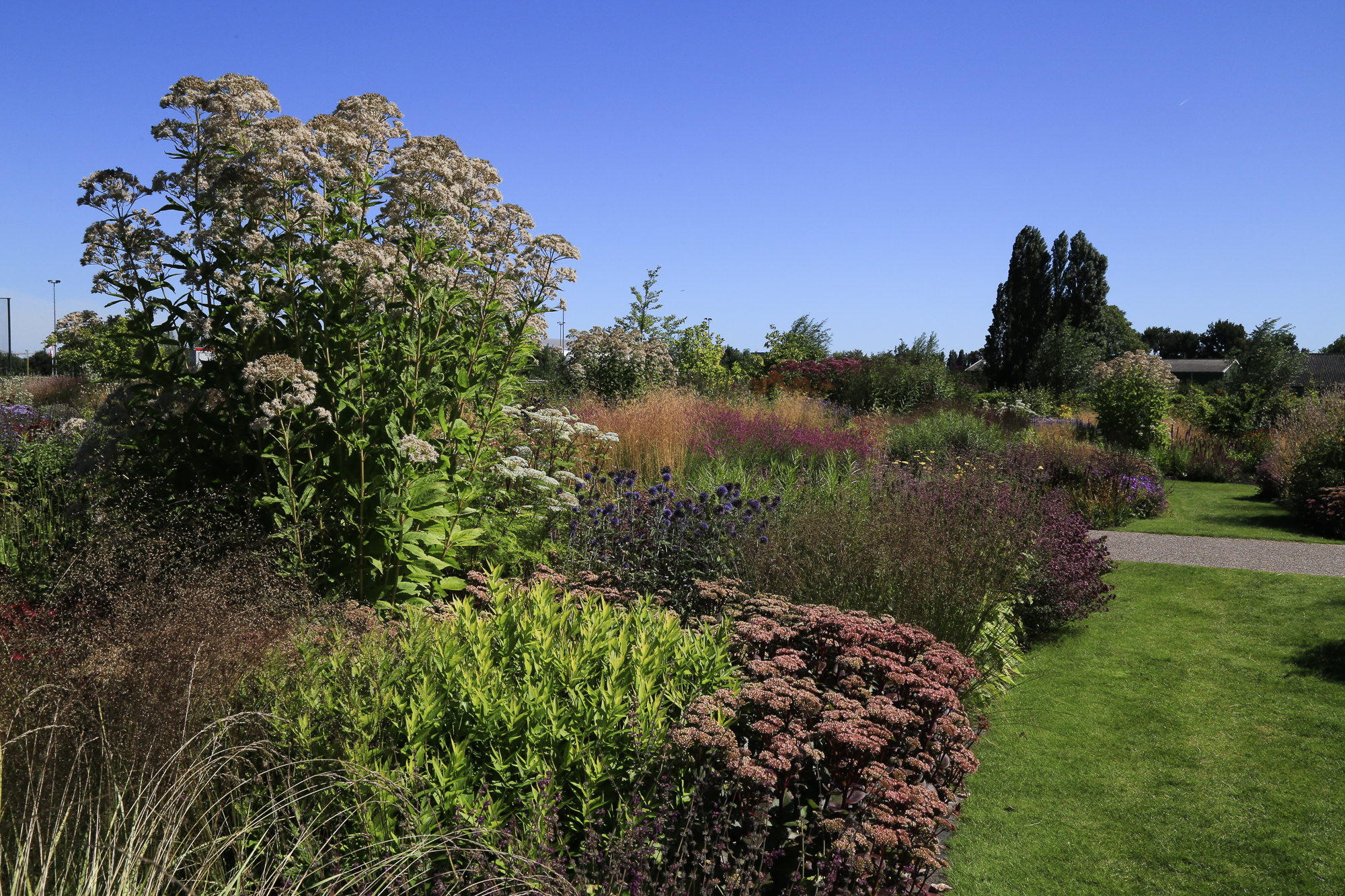 Vlinderhof is amazingly young. The paths were laid out and trees planted in autumn of 2013 and the perennials were planted in spring of 2014, so when we visited with carexTours in August 2016, the garden was only a bit over two years old.
Vlinderhof is amazingly young. The paths were laid out and trees planted in autumn of 2013 and the perennials were planted in spring of 2014, so when we visited with carexTours in August 2016, the garden was only a bit over two years old.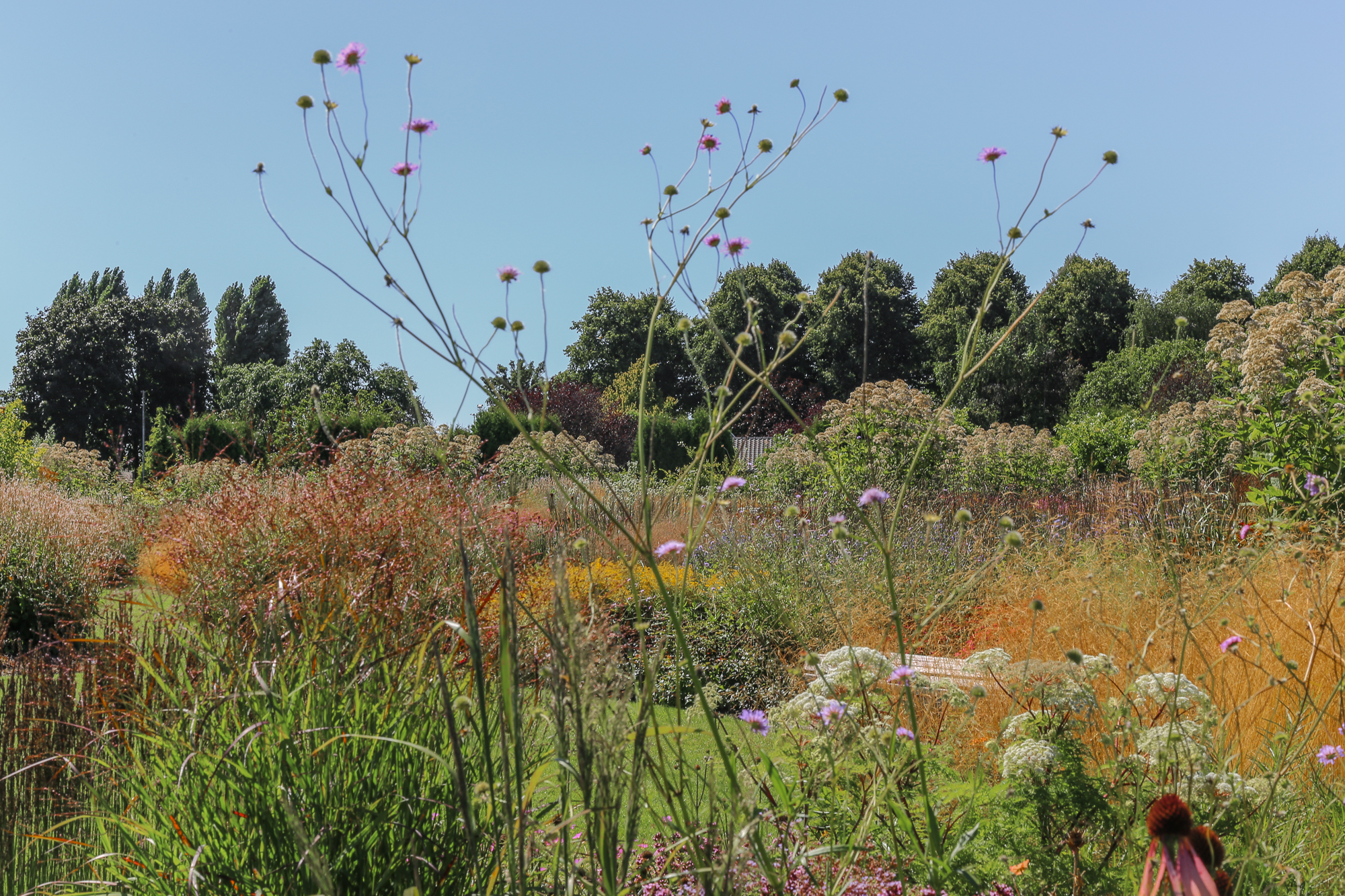 Walking through Vlinderhof I was amazed at the maturity of the planting. The plants envelope you as you stroll the wide paths, meandering among huge billowing mounds of perennials and grasses. This is the reverse of traditional island bedding because the vast majority of the garden space is planted. The paths are simply a way to make your way through.
Walking through Vlinderhof I was amazed at the maturity of the planting. The plants envelope you as you stroll the wide paths, meandering among huge billowing mounds of perennials and grasses. This is the reverse of traditional island bedding because the vast majority of the garden space is planted. The paths are simply a way to make your way through. Much of the garden is anchored by pylons of an immense white Joe Pye Weed (Eupatorium maculatum 'Snowball') that must be at least 12 feet tall.
Much of the garden is anchored by pylons of an immense white Joe Pye Weed (Eupatorium maculatum 'Snowball') that must be at least 12 feet tall.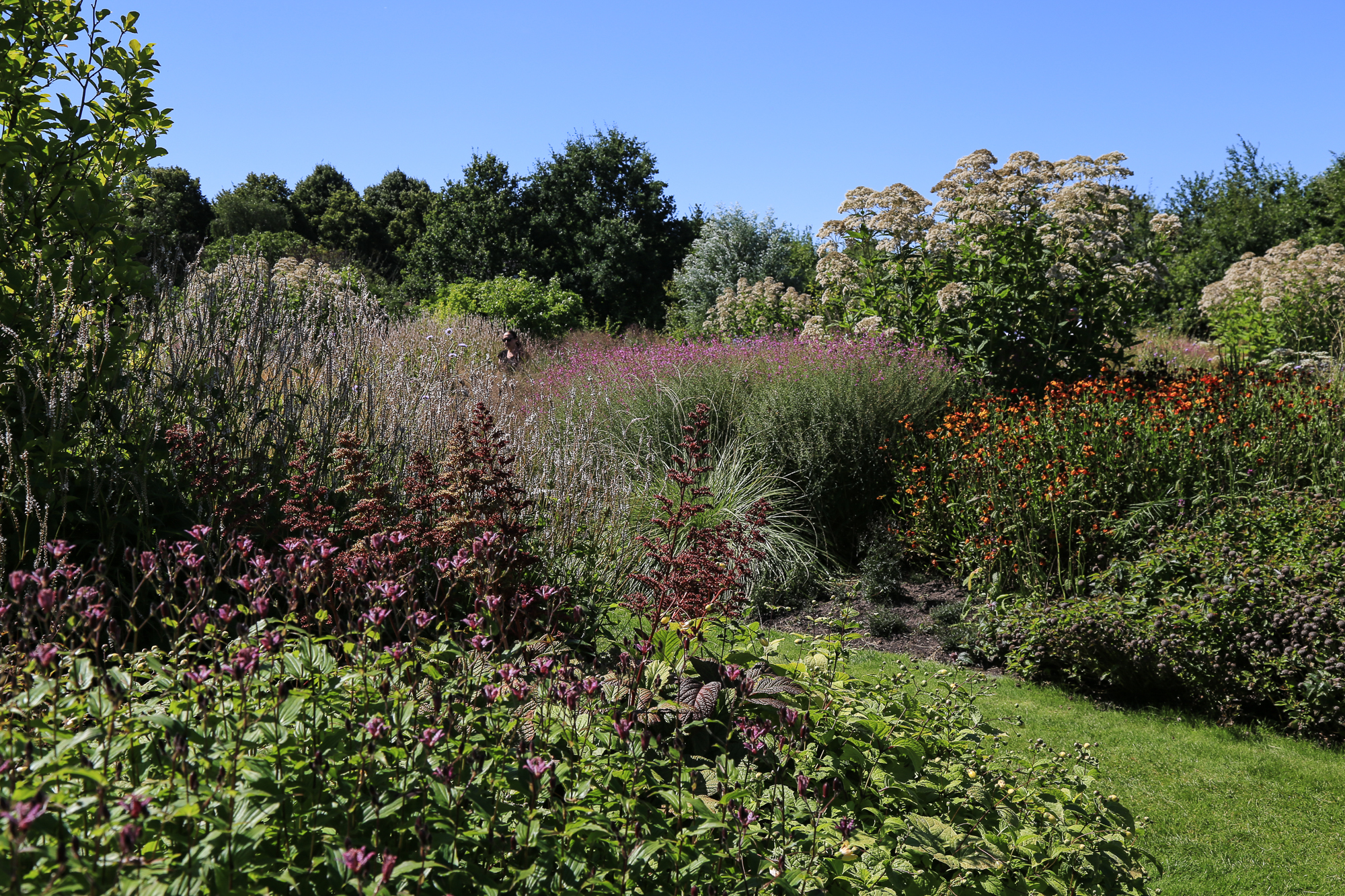 Here you can see several of the huge Joe Pye's scattered across the garden. The human figure in the left center demonstrates the scale of the Vlinderhof plantings and gives a measure of the height and breadth of the Eupatorium structures.
Here you can see several of the huge Joe Pye's scattered across the garden. The human figure in the left center demonstrates the scale of the Vlinderhof plantings and gives a measure of the height and breadth of the Eupatorium structures. But areas of shorter plantings allow views through to other parts of the garden.
But areas of shorter plantings allow views through to other parts of the garden.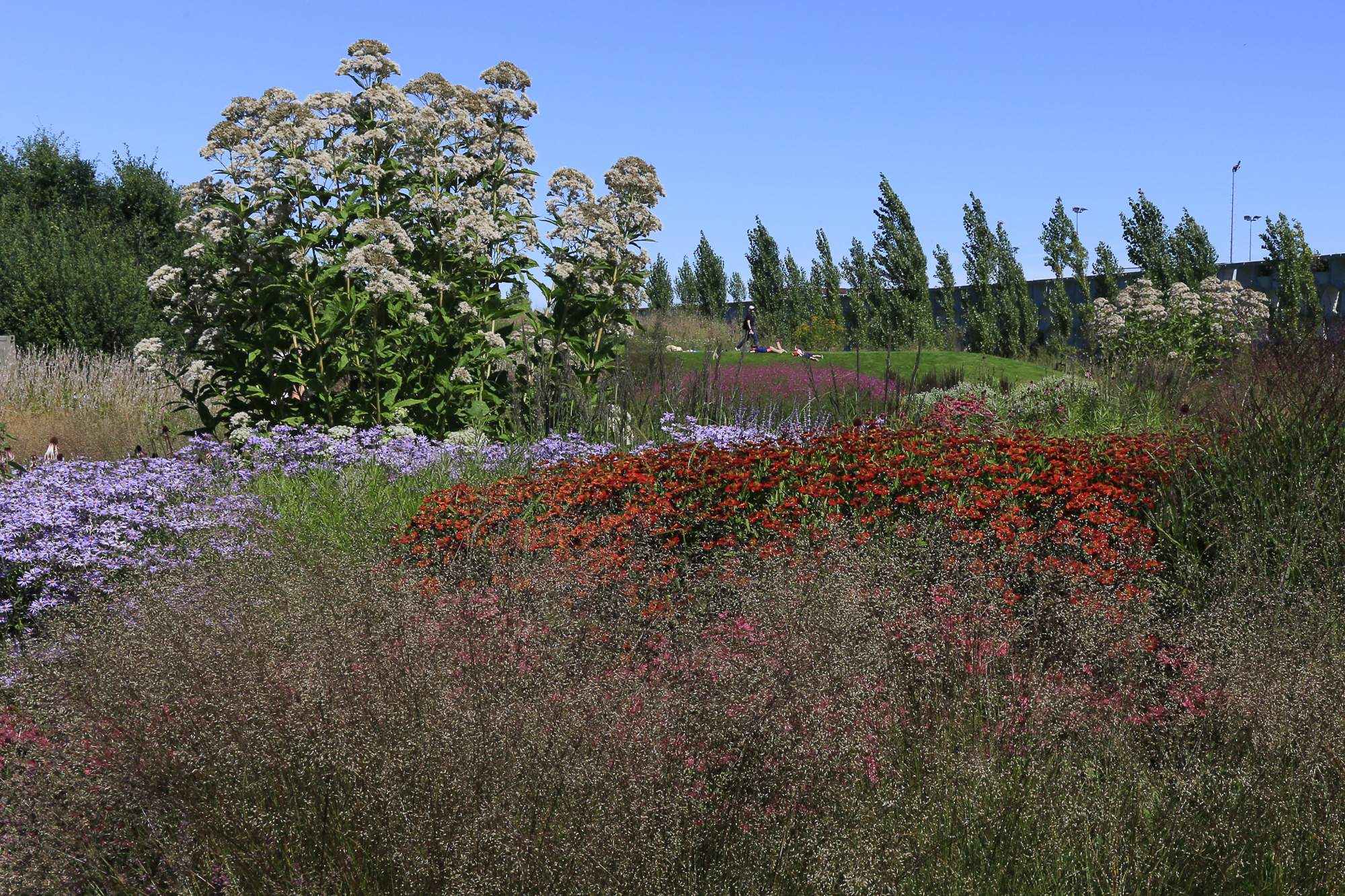 Though most of the plantings are blocks of perennials and grasses, Oudolf varied the shapes and sizes of the blocks, so here we see what appears to be a linear stream of blue Asters running through the other perennials. The large white towers of Joe Pye are ubiquitous, carrying the eye across the garden and up to the sky, creating a dazzling, joyful, experience on a bright summer day.
Though most of the plantings are blocks of perennials and grasses, Oudolf varied the shapes and sizes of the blocks, so here we see what appears to be a linear stream of blue Asters running through the other perennials. The large white towers of Joe Pye are ubiquitous, carrying the eye across the garden and up to the sky, creating a dazzling, joyful, experience on a bright summer day.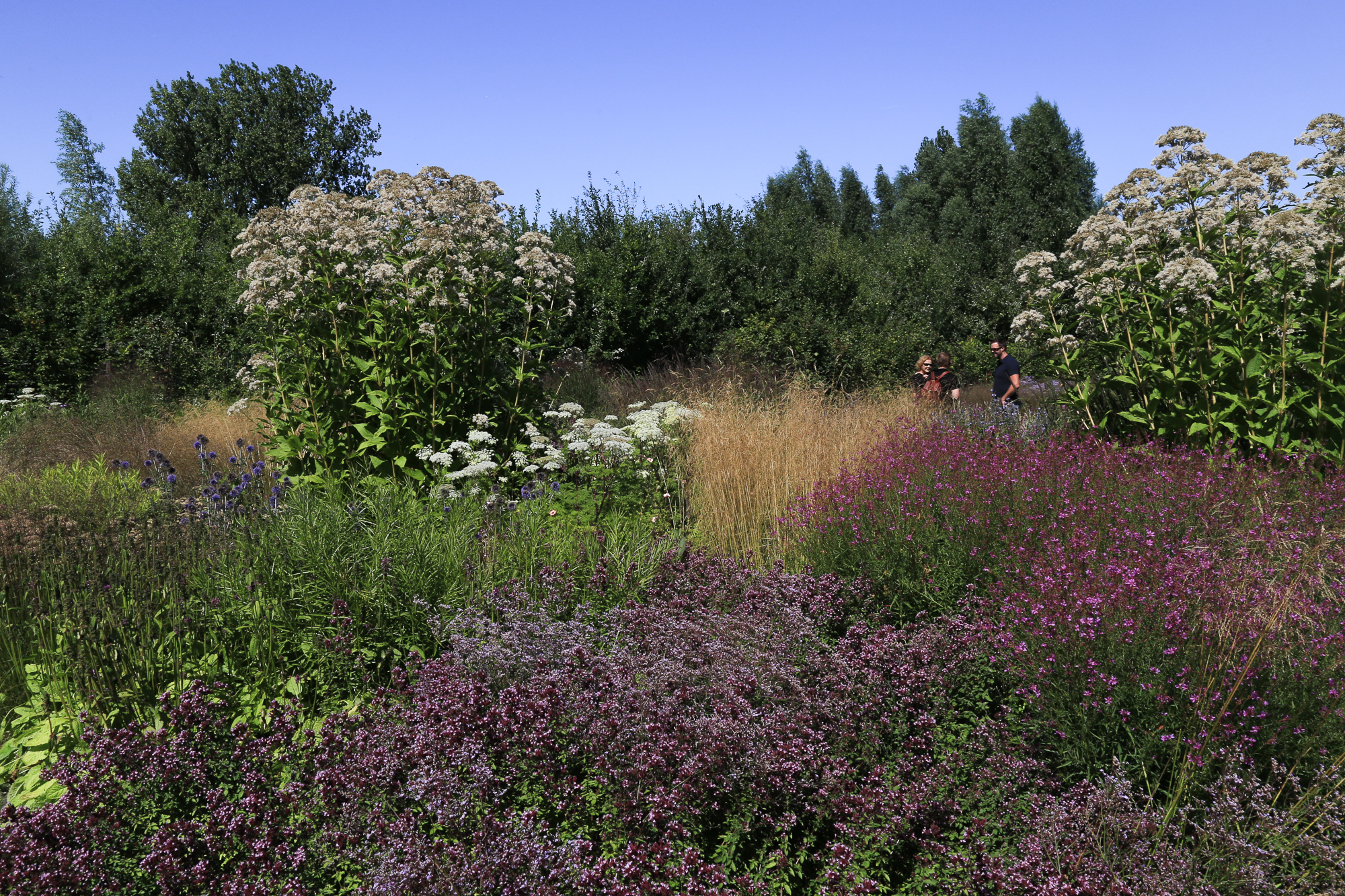 Here some members of our tour group appear dwarfed in the distance by the undulating waves of plants. (Can you find them?)
Here some members of our tour group appear dwarfed in the distance by the undulating waves of plants. (Can you find them?)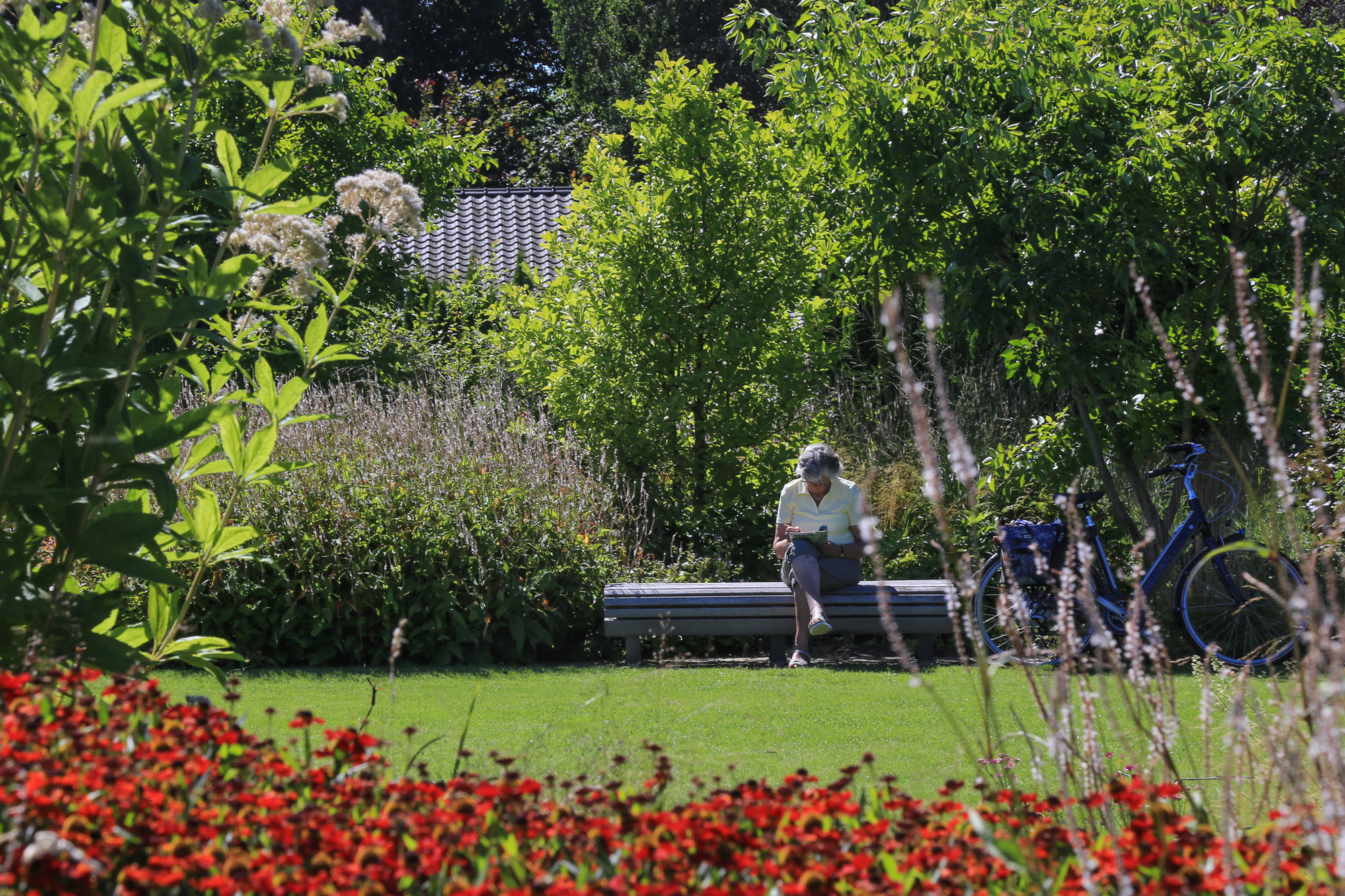 A few open areas and beautifully designed seating make it easy for residents to use Vlinderhof for recreation and leisure. This woman has ridden her bicycle to the park and is reading a magazine.
A few open areas and beautifully designed seating make it easy for residents to use Vlinderhof for recreation and leisure. This woman has ridden her bicycle to the park and is reading a magazine. The seating is designed with elegant form and made of natural materials that complement the exuberant plantings. The flat, gray color and rounded shapes modulate the bright sunlight, so the eye sees a pleasing range of darker and brighter shades as it moves over the curved surface of the seat. The attention to detail at Vlinderhof is remarkable.
The seating is designed with elegant form and made of natural materials that complement the exuberant plantings. The flat, gray color and rounded shapes modulate the bright sunlight, so the eye sees a pleasing range of darker and brighter shades as it moves over the curved surface of the seat. The attention to detail at Vlinderhof is remarkable.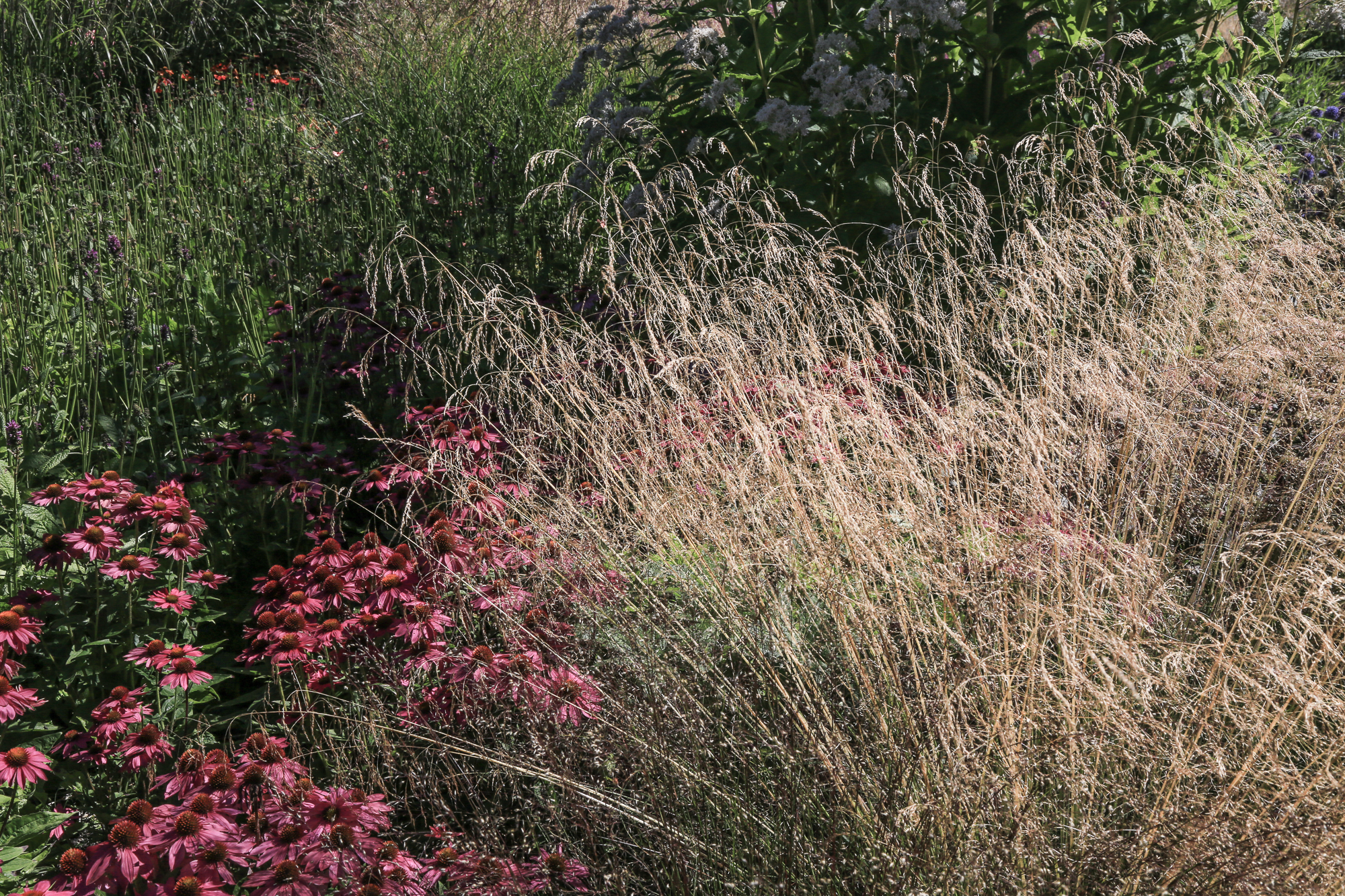 The same is true of the plantings ... the fireworks of a simple grass (Deschampsia) lightly overhanging the bright Echinacea ... the contrast of the light, feathery grass with the solid, brightly colored flower disks.
The same is true of the plantings ... the fireworks of a simple grass (Deschampsia) lightly overhanging the bright Echinacea ... the contrast of the light, feathery grass with the solid, brightly colored flower disks. And here, the umbellifer to die for, Selinum wallichianum, with its fine fern-like foliage, emerging from the background of the same Deschampsia ...
And here, the umbellifer to die for, Selinum wallichianum, with its fine fern-like foliage, emerging from the background of the same Deschampsia ... ... and a closer view, just so you can appreciate the flowers.
... and a closer view, just so you can appreciate the flowers. Here horizontal layering of the stalwart prairie grass Sporobolus heterolepis, backed by Aster tartaricus 'Jindai', which will flower in the autumn, and a block of pink flowers behind ...
Here horizontal layering of the stalwart prairie grass Sporobolus heterolepis, backed by Aster tartaricus 'Jindai', which will flower in the autumn, and a block of pink flowers behind ...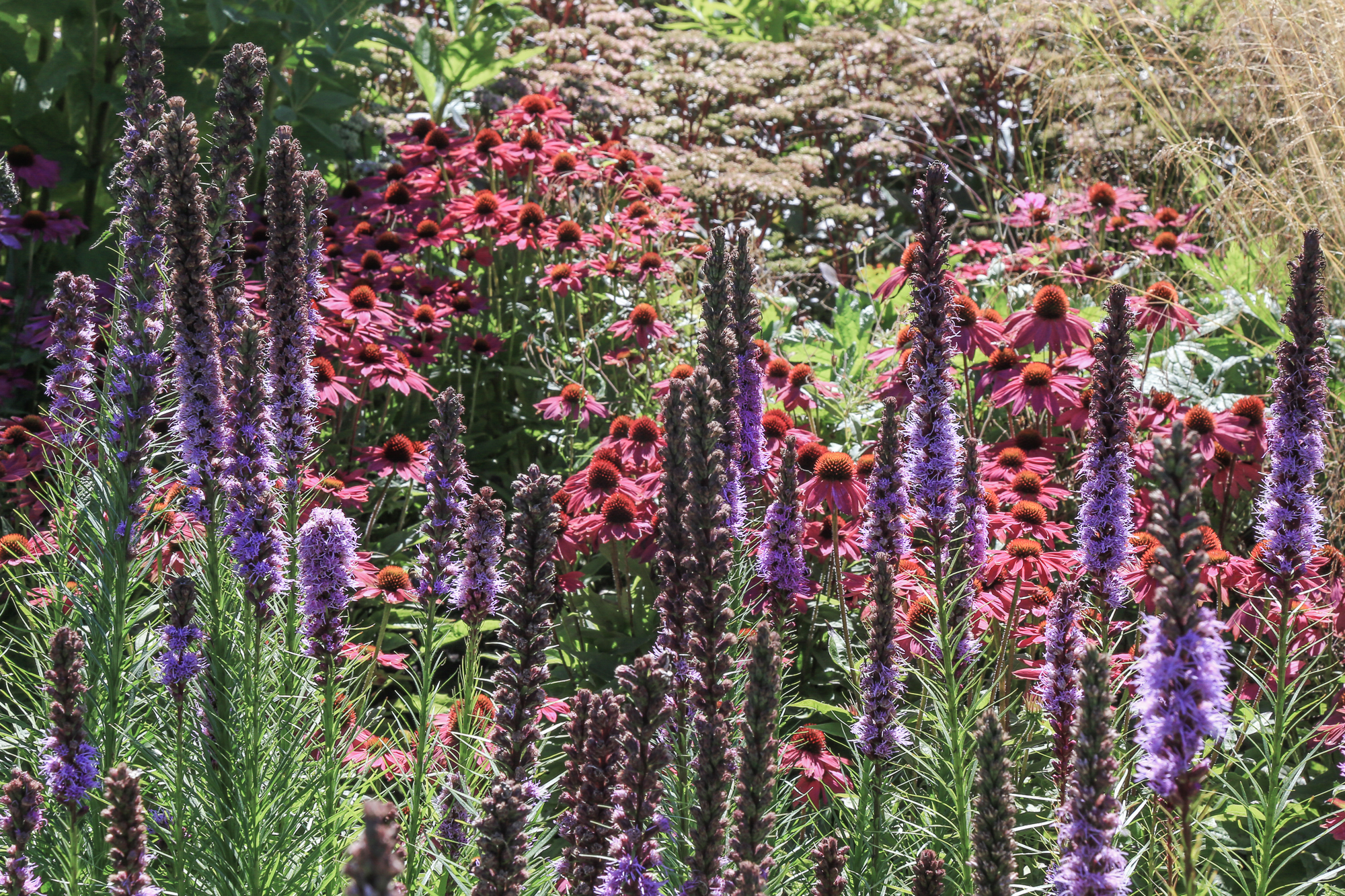 ... and here a bold planting of Liatris spicata and Echinacea.
... and here a bold planting of Liatris spicata and Echinacea.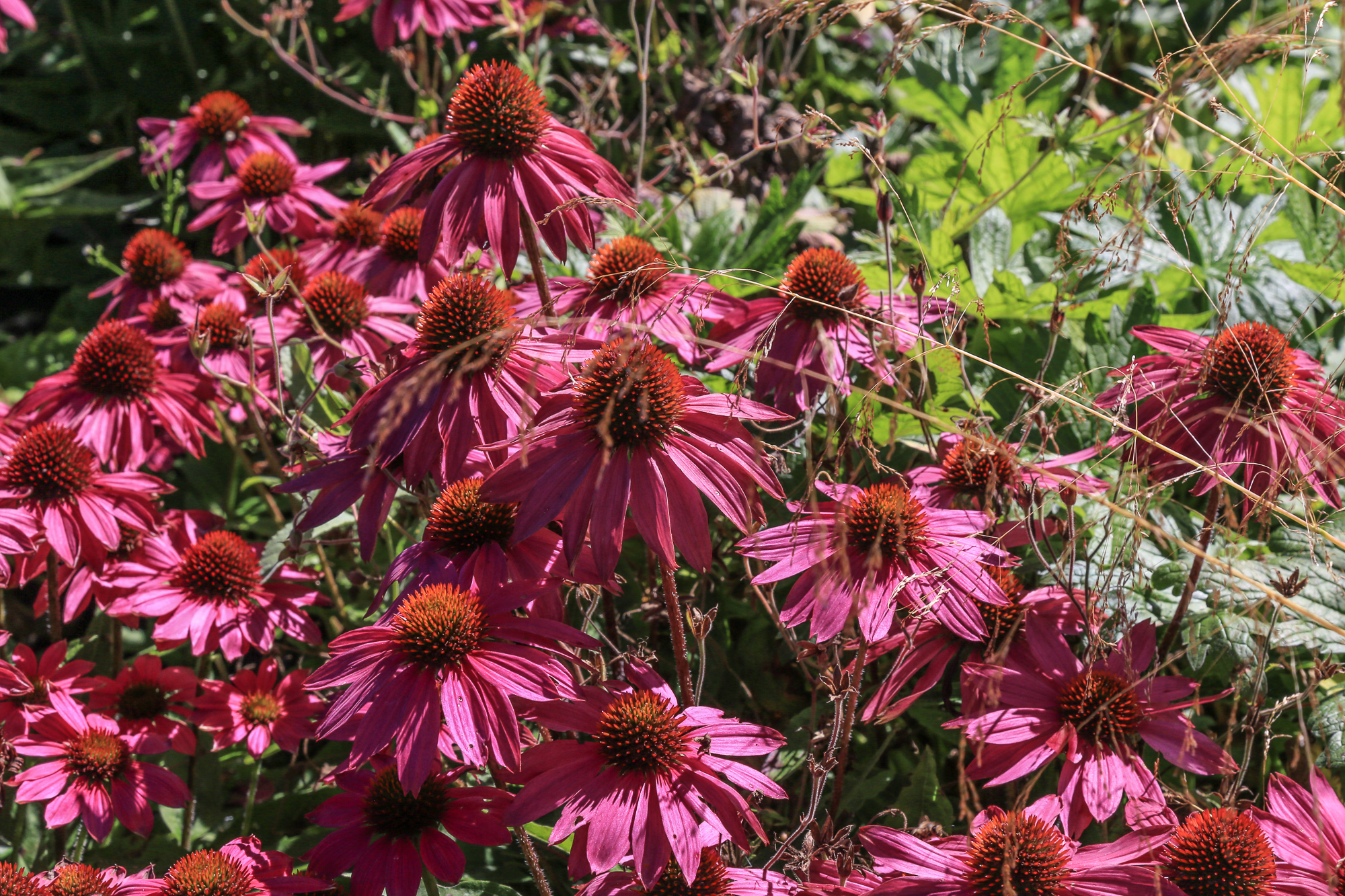 Though we visited on a very bright day, with the sun almost directly overhead ...
Though we visited on a very bright day, with the sun almost directly overhead ...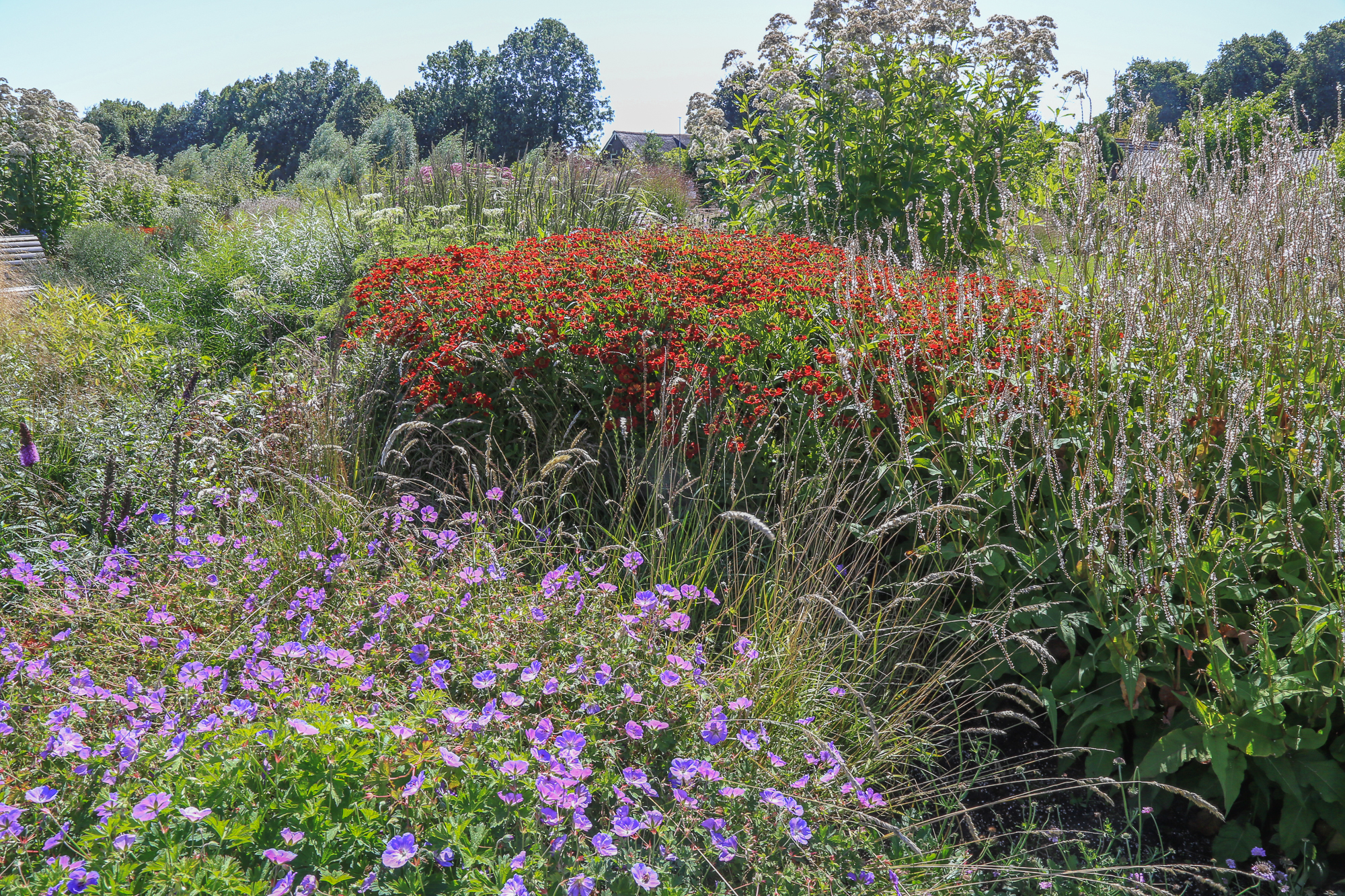 ... Oudolf selected a number of intensely colored flowering plants capable of holding their own, even under the harsh light ...
... Oudolf selected a number of intensely colored flowering plants capable of holding their own, even under the harsh light ...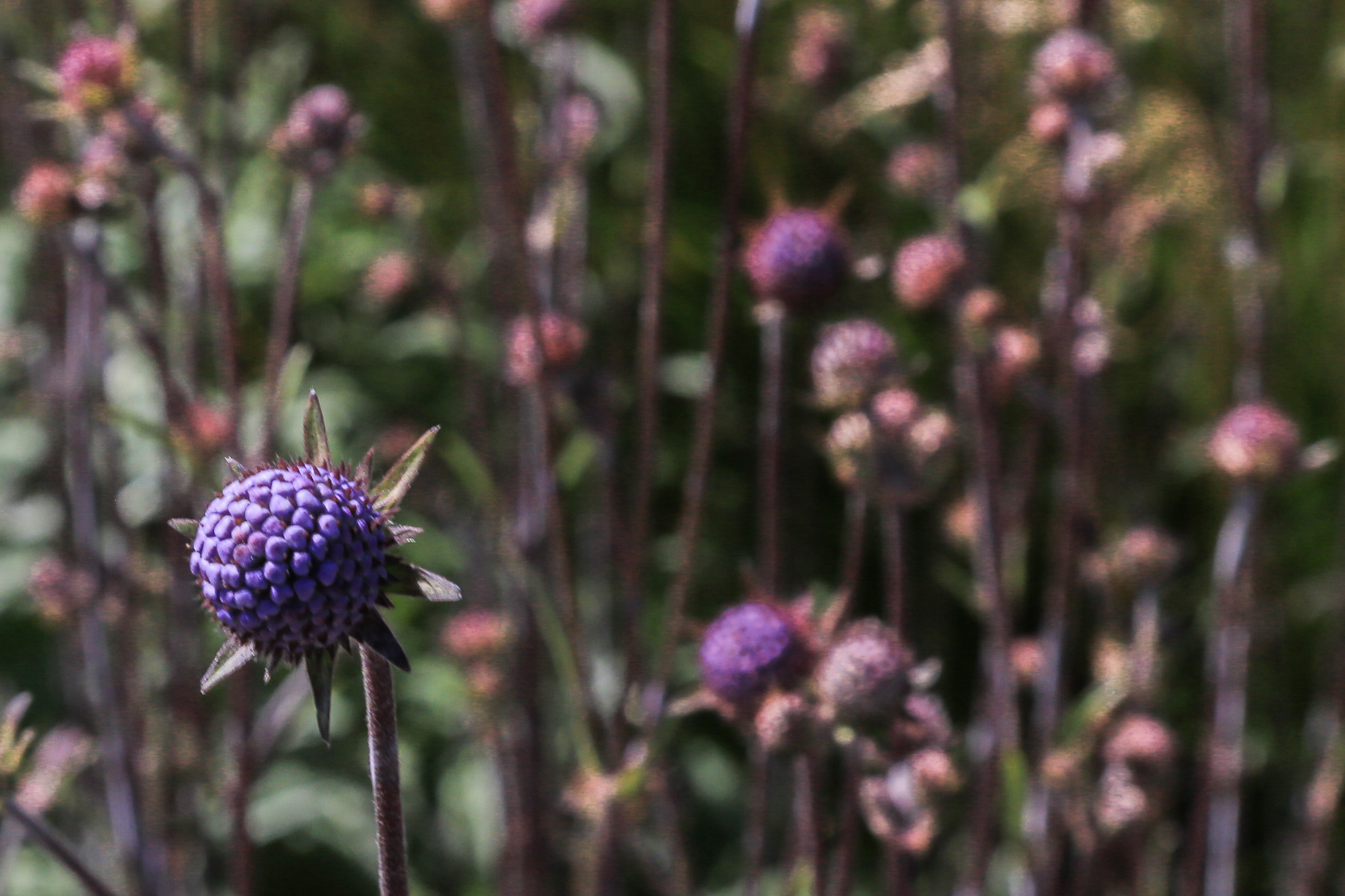 ... as well as some beauties I've rarely seen, such as this Devil's Bit Scabious (Succisa pratensis) ...
... as well as some beauties I've rarely seen, such as this Devil's Bit Scabious (Succisa pratensis) ... ... and plants more familiar to us in the US ... the flowers of Heuchera villosa ...
... and plants more familiar to us in the US ... the flowers of Heuchera villosa ...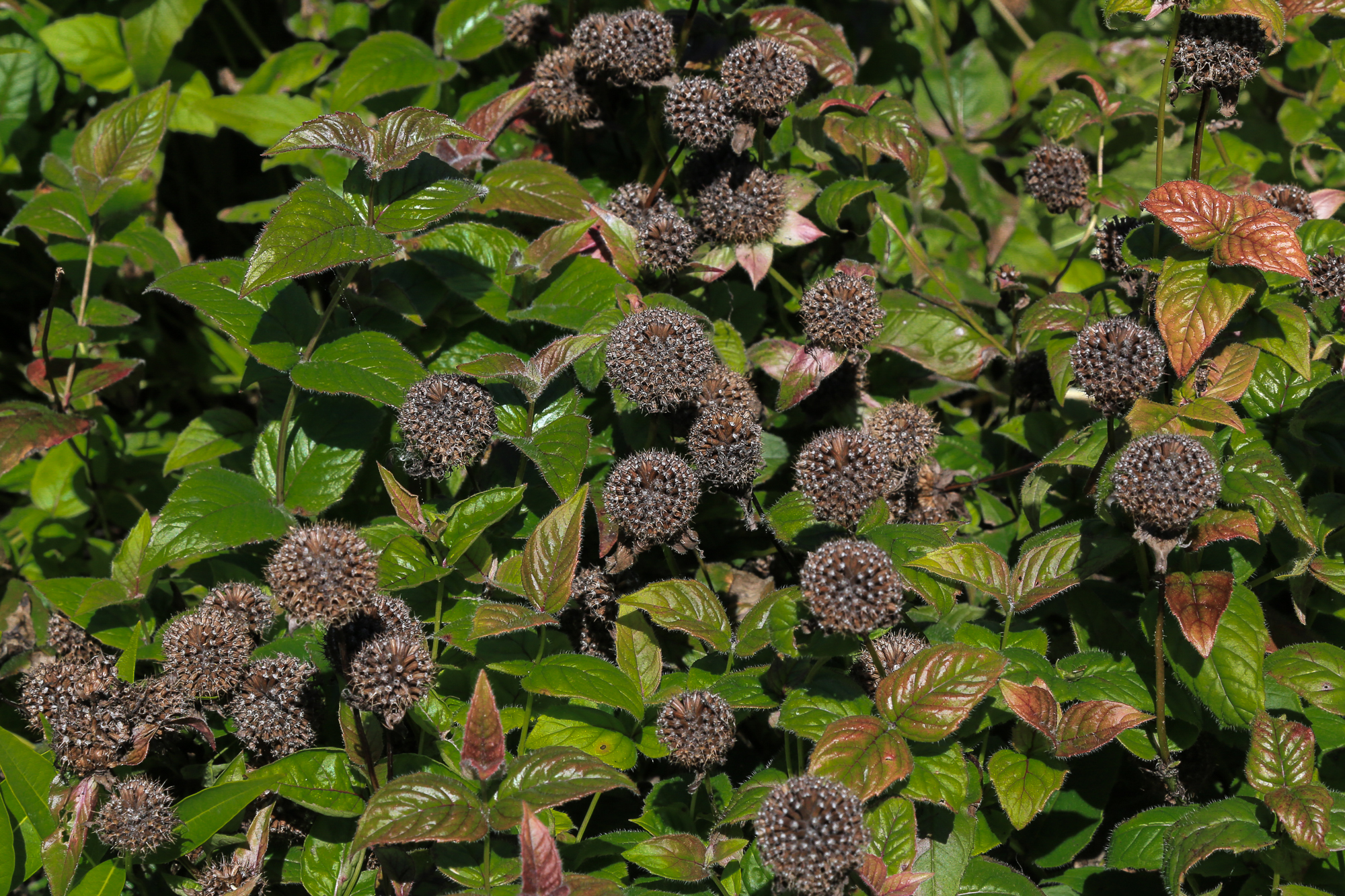 ... and the seed heads of Monarda bradburiana ...
... and the seed heads of Monarda bradburiana ...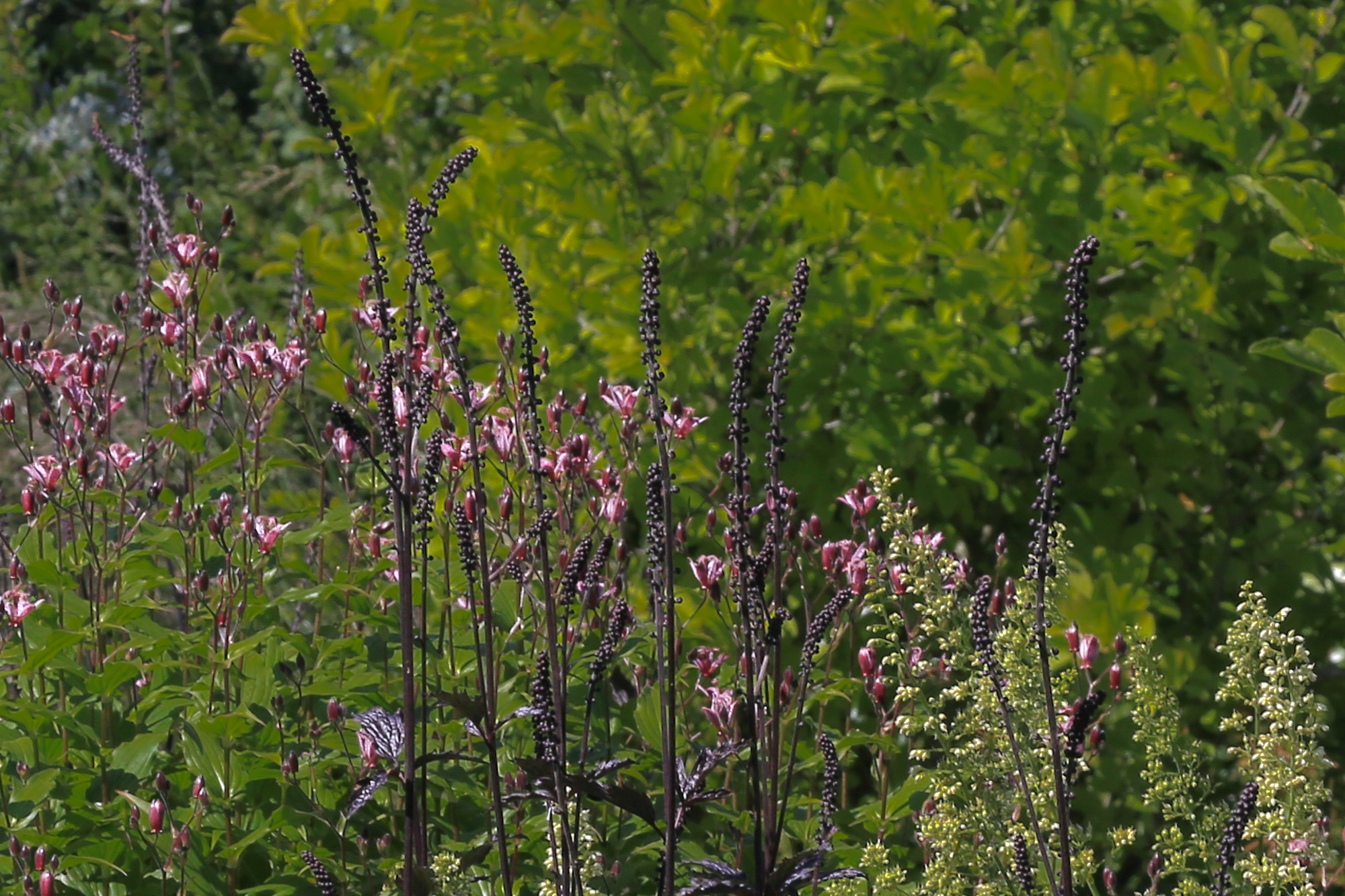 ... the tall almost black spires of Cimicifuga ramosa 'Brunette' against a pink flowering Toad Lily (Tricyrtis) ...
... the tall almost black spires of Cimicifuga ramosa 'Brunette' against a pink flowering Toad Lily (Tricyrtis) ...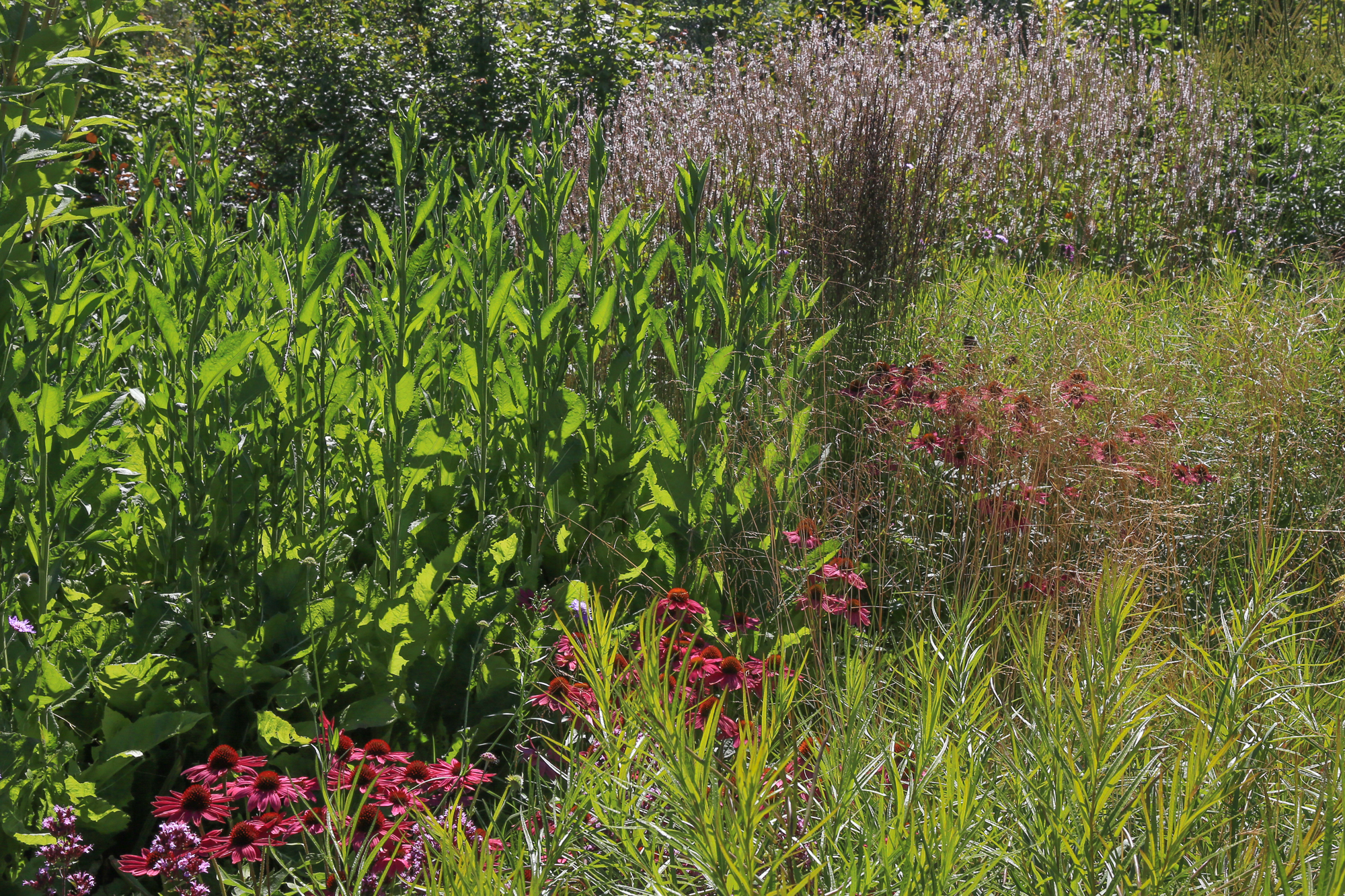 ... here a "stream" of Echinacea flowing between Aster tartaricus (an autumn bloomer) and Palm sedge (Carex muskingumensis) ...
... here a "stream" of Echinacea flowing between Aster tartaricus (an autumn bloomer) and Palm sedge (Carex muskingumensis) ...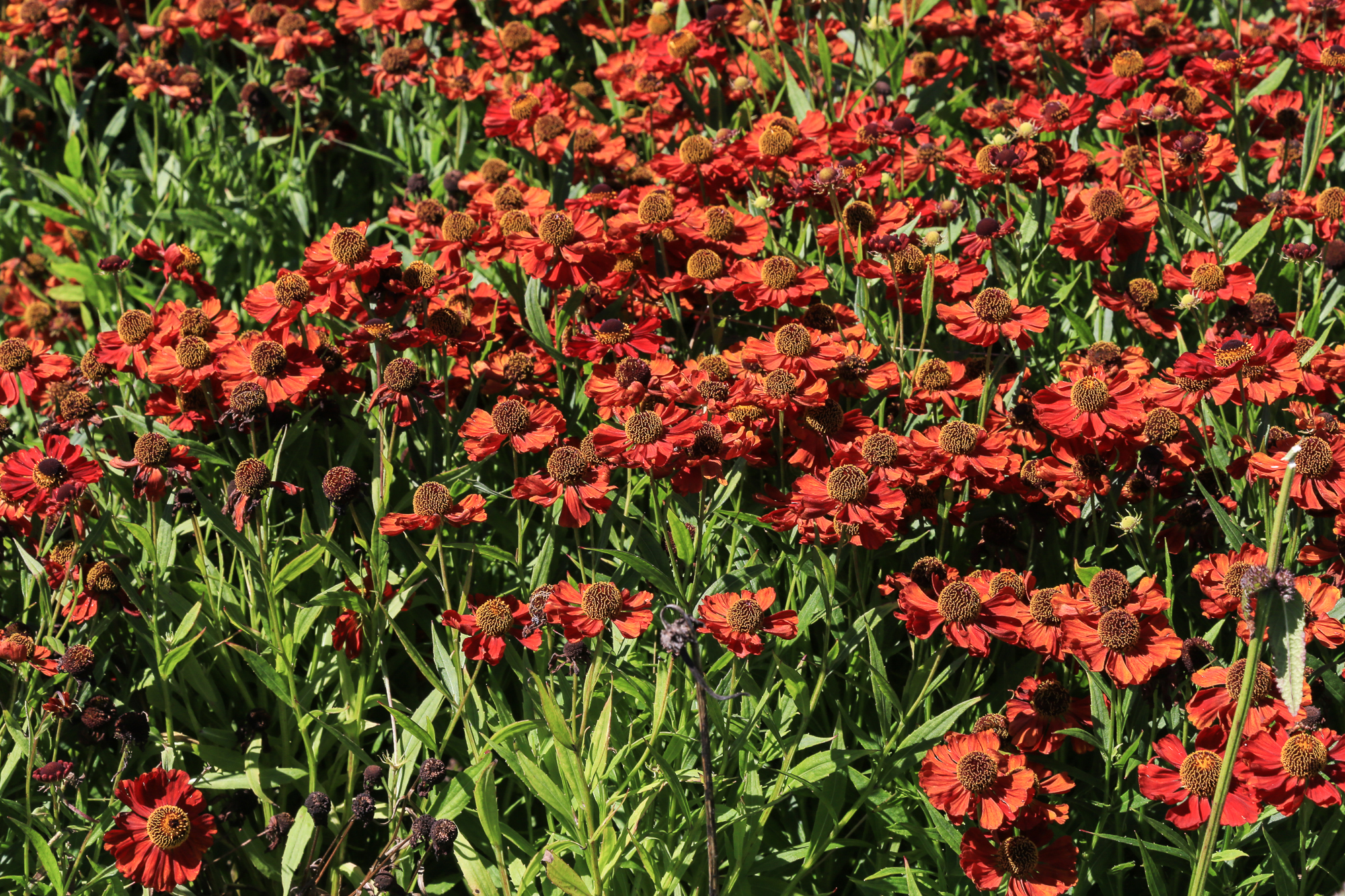 ... and a bright orange Helenium.
... and a bright orange Helenium.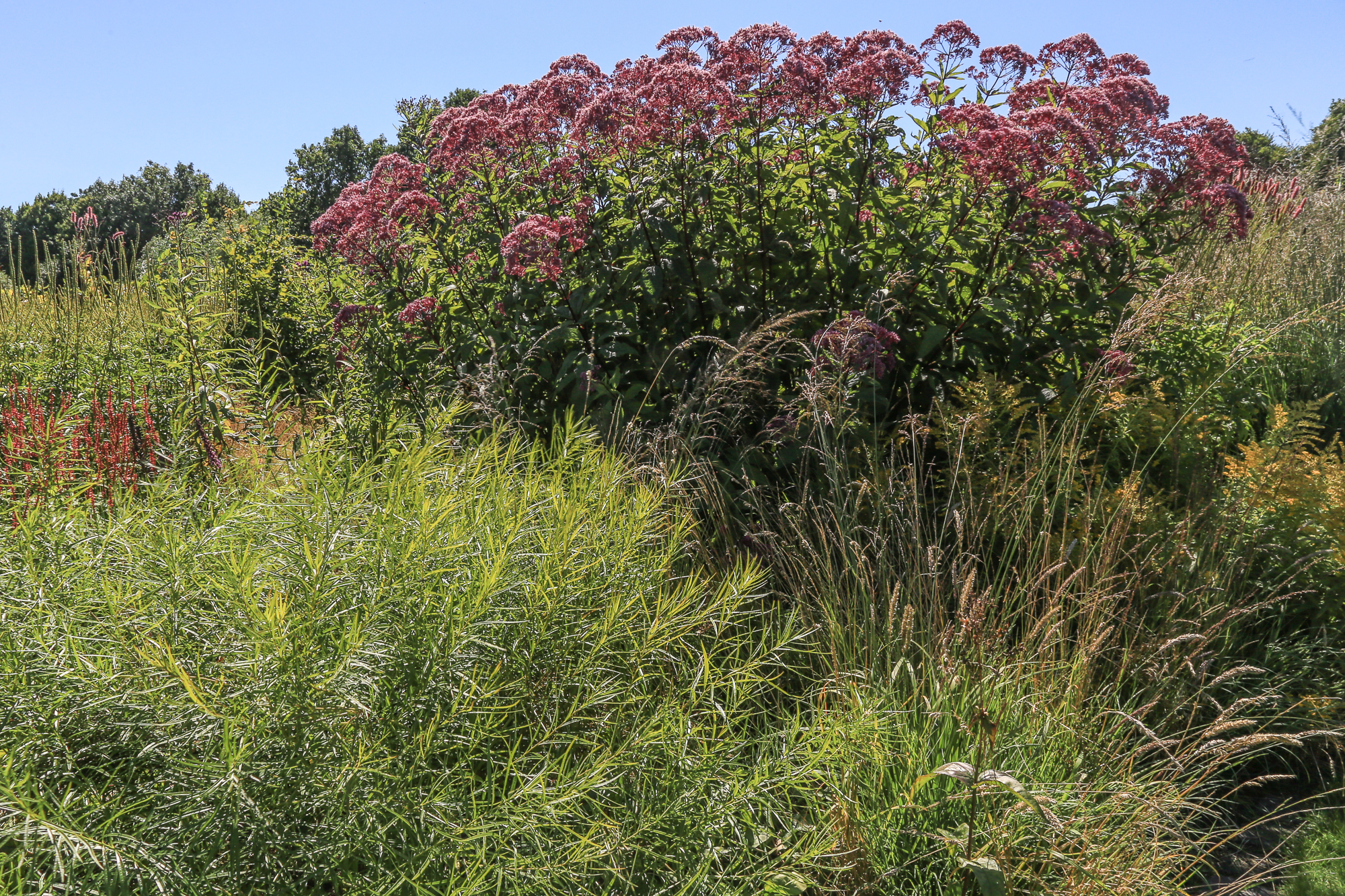 Vlinderhof gives visitors huge scale, an opportunity to stroll through tall, thick plantings that dwarf the human form ...
Vlinderhof gives visitors huge scale, an opportunity to stroll through tall, thick plantings that dwarf the human form ...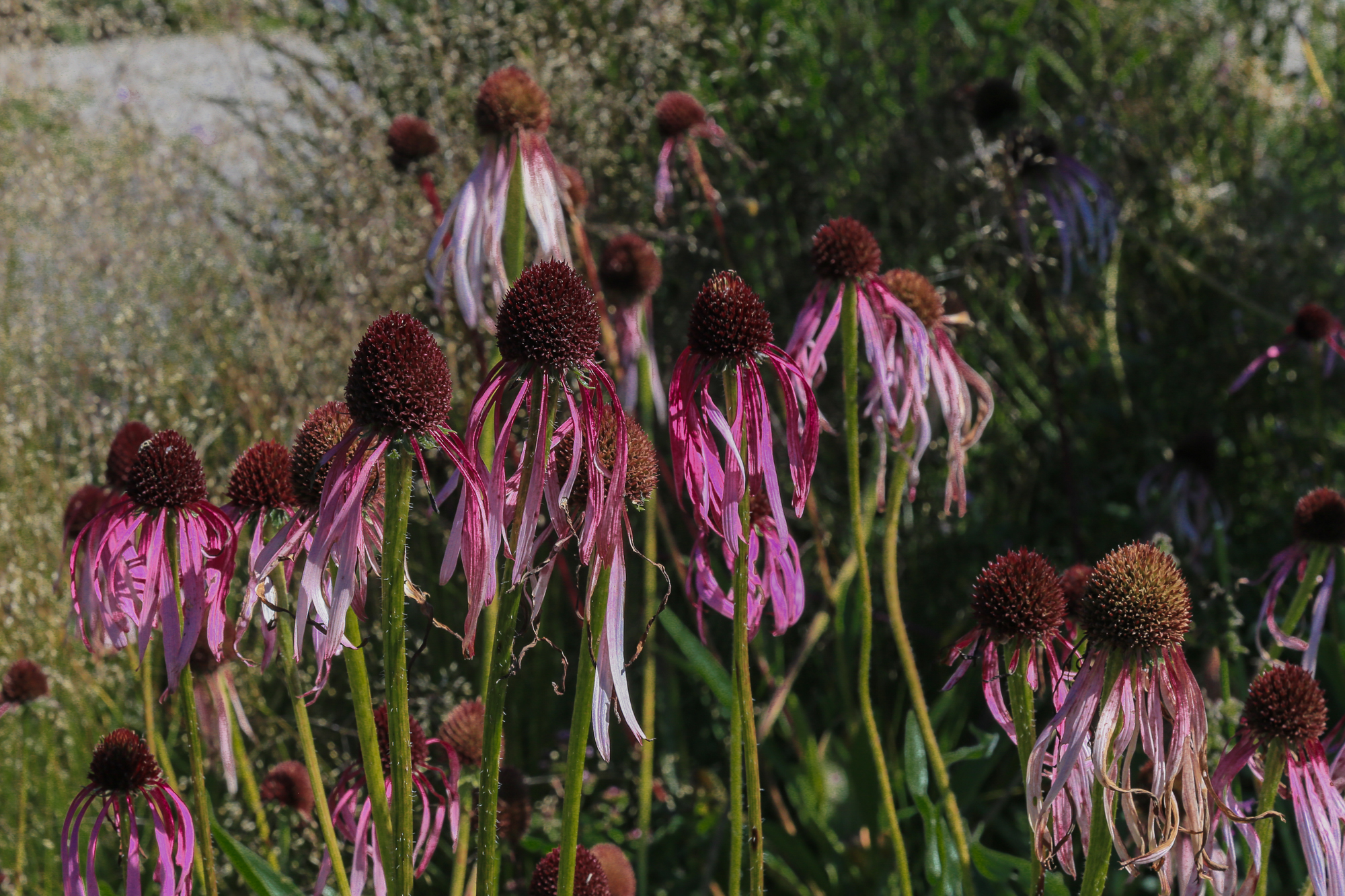 ... as well as many smaller delights where you can become absorbed in the details of flower form and structure, as with the reflexed petals of this Echinacea pallida, which probably looks its best at this moment of disintegration ...
... as well as many smaller delights where you can become absorbed in the details of flower form and structure, as with the reflexed petals of this Echinacea pallida, which probably looks its best at this moment of disintegration ...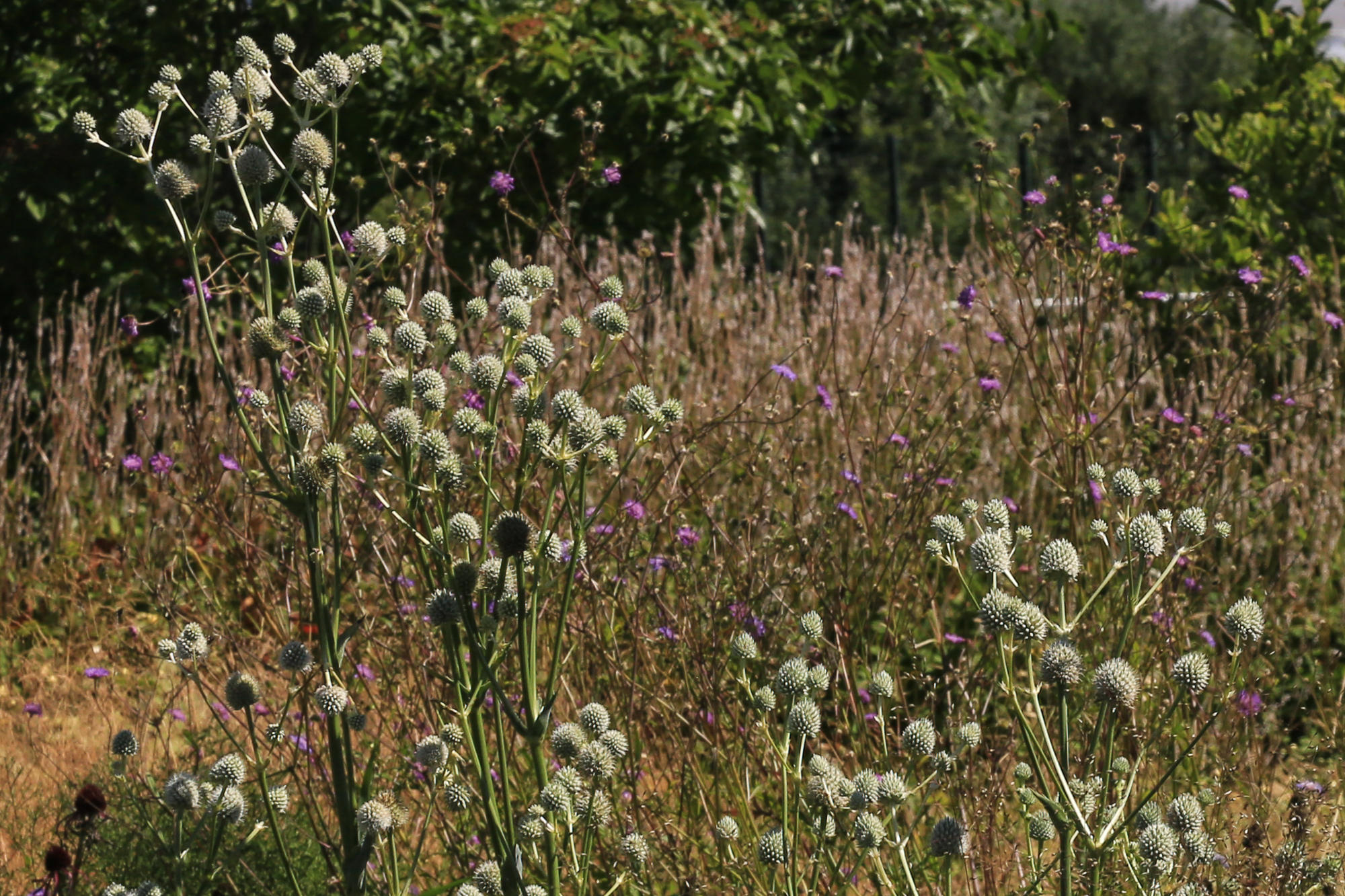 ... the decorative seed heads of Rattlesnake Master (Eryngium yuccafolium) ...
... the decorative seed heads of Rattlesnake Master (Eryngium yuccafolium) ...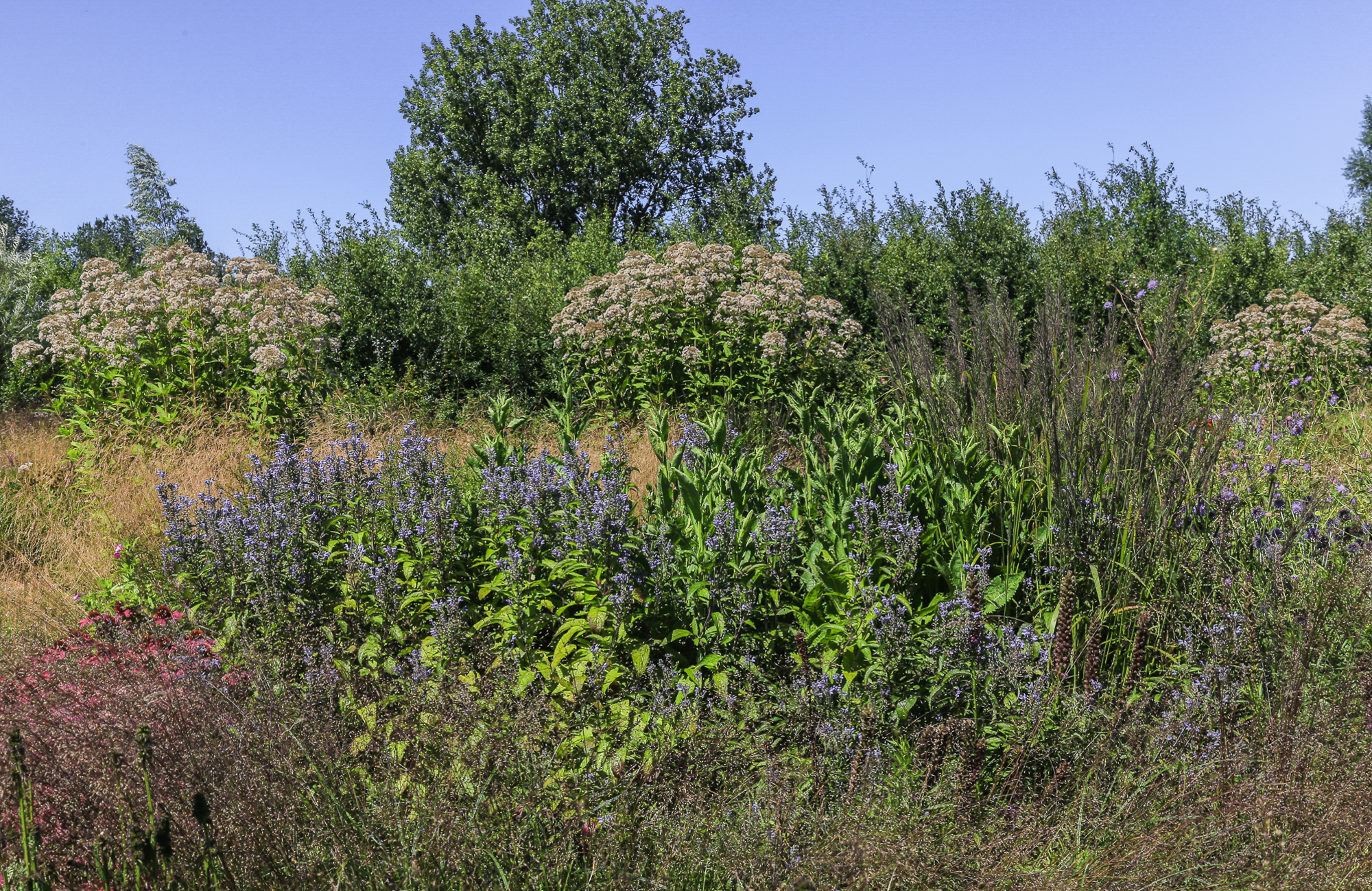 ... or this mass of Scutellaria incana introducing a rare blue into this large planting.
... or this mass of Scutellaria incana introducing a rare blue into this large planting.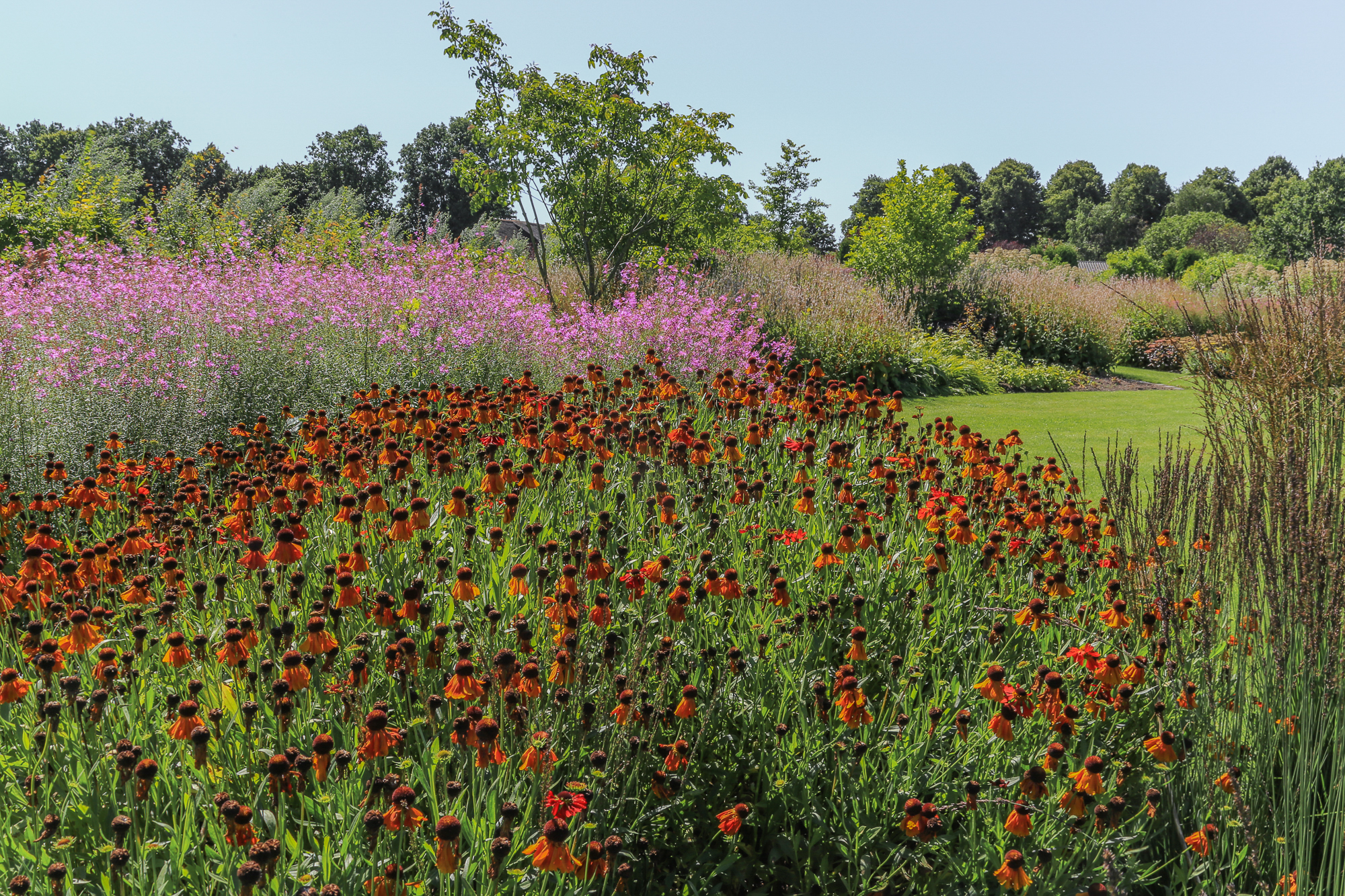 Vlinderhof is a joyful, "big sky" space. On the bright, warm August day we visited, the plants seemed to exist for our pleasure. The tall trees at the edge of the garden were waving in the breeze, the park visitors lay on the ground, picnicked, bicycled, read, chatted. I think the proof of the success of this Oudolf design is that people seem to love to use it. They appreciate it and don't abuse it. There's clearly a feeling of mutual respect, which we need so desperately in this troubled world.On leaving, I continued to be astonished that this garden, so different from Hummelo, demonstrates yet another side of Oudolf's talent, his ability to continue to respond to place and human need with extraordinarily creative design.
Vlinderhof is a joyful, "big sky" space. On the bright, warm August day we visited, the plants seemed to exist for our pleasure. The tall trees at the edge of the garden were waving in the breeze, the park visitors lay on the ground, picnicked, bicycled, read, chatted. I think the proof of the success of this Oudolf design is that people seem to love to use it. They appreciate it and don't abuse it. There's clearly a feeling of mutual respect, which we need so desperately in this troubled world.On leaving, I continued to be astonished that this garden, so different from Hummelo, demonstrates yet another side of Oudolf's talent, his ability to continue to respond to place and human need with extraordinarily creative design.
To see Dutch photographer Hans van Horssen's videos of Vlinderhof, click here.